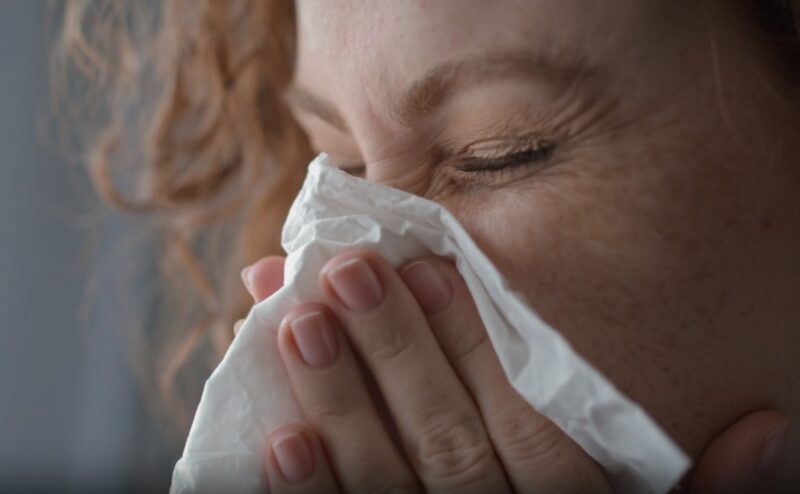Allergies, especially those triggered by dust, pose significant challenges to many individuals. Dust allergies are not just a minor inconvenience; they can seriously disrupt daily life, causing symptoms that range from mildly irritating to debilitating.
At the heart of these allergies are dust mites, microscopic organisms that thrive in household dust.
Their presence can trigger allergic reactions in sensitive individuals, leading to symptoms like sneezing, coughing, itchy eyes, and even asthma attacks. While medical treatments are valuable, exploring natural cures offers a complementary or alternative route.
These natural approaches are often more sustainable and accessible, focusing on reducing exposure to allergens and boosting the body’s natural defense mechanisms against allergic reactions.
What is the Easiest Solution?
The quality of the air we breathe indoors plays a crucial role in managing dust allergies. Improving air quality involves strategies like maintaining cleanliness and using air purifiers.
Set a Regular Cleaning Routine

Keeping a clean home is essential in controlling dust allergies. Regularly dusting and vacuuming can significantly reduce the presence of dust mites, the main allergens in dust. It’s important to use the right cleaning tools and techniques to effectively remove dust without scattering allergens into the air.
Air Purification Methods
Using air purifiers, especially those with HEPA filters, can effectively remove dust particles and other allergens from the air, further improving indoor air quality. Additionally, regularly replacing air filters in heating and cooling systems can help maintain clean air in the home.
- Effective Cleaning Tools: Utilize microfiber cloths and damp mops to effectively trap and remove dust without dispersing it into the air.
- Vacuuming Frequency: It’s recommended to vacuum at least twice a week, with a focus on carpets, upholstery, and areas that tend to accumulate dust.
- Air Purifier Placement: Strategically place air purifiers in areas of the home where you spend the most time, such as living rooms and bedrooms, to maximize their effectiveness.
Natural Remedies and Supplements
Natural remedies and supplements can play a significant role in alleviating the symptoms of dust allergies. This section explores various herbal treatments and dietary supplements that can help manage allergy symptoms.
Herbal Treatments

Certain herbs, like butterbur and stinging nettle, have shown potential in easing allergy symptoms. They may work by suppressing histamine production or acting as anti-inflammatory agents, providing natural relief from allergic reactions.
| Herbal Treatment | How to Use? | Benefits for Dust Allergy | Potential Side Effects |
|---|---|---|---|
| Butterbur | Consume in the form of supplements as directed | Acts as a natural antihistamine | Gastrointestinal issues, headache, allergic reactions |
| Quercetin | Available in supplements or in foods like onions and apples | Stabilizes mast cells to reduce allergy symptoms | Headaches, tingling sensation in arms and legs |
| Stinging Nettle | Available as dried herb, tea, or in capsule form | May reduce histamine production | Mild stomach upset, allergic reactions |
| Bromelain | Found in pineapples or as a supplement | Helps reduce nasal swelling and thin mucus | Gastrointestinal discomfort, allergic reactions if allergic to pineapple |
| Spirulina | Consumed as a supplement or added to foods | May improve symptoms of allergic rhinitis | Muscle pain, liver damage (in very high doses) |
Dietary Supplements
Supplements like omega-3 fatty acids and quercetin can be beneficial in managing allergy symptoms. Omega-3s, commonly found in fish oil, and quercetin, a plant-derived compound, can reduce inflammation and enhance the immune system’s response to allergens.
- Supplement Dosage: It’s important to consult with a healthcare provider to determine the appropriate dosages of supplements to ensure safety and effectiveness.
- Dietary Adjustments: Incorporating foods rich in omega-3 fatty acids, such as salmon and walnuts, into your diet can help reduce inflammation associated with allergic reactions.
Lifestyle Changes
Modifying the lifestyle can have a profound impact on managing dust allergy symptoms.
Stress Reduction Techniques

Stress can worsen allergy symptoms, making it essential to incorporate stress reduction techniques into your daily routine. Practices like yoga, meditation, and deep breathing exercises can help reduce stress levels, thus potentially mitigating the severity of allergic reactions.
Get Enough Sleep
Ensuring sufficient and quality sleep is vital for the immune system’s proper functioning. Establishing a regular sleep schedule and creating a conducive sleep environment can help in managing allergy symptoms more effectively.
- Yoga and Meditation: Engaging in daily practices of yoga and meditation can significantly reduce stress, thereby potentially reducing the frequency and severity of allergy symptoms.
- Sleep Hygiene: Maintaining a consistent sleep schedule and creating a bedroom environment that promotes restful sleep can play a crucial role in allergy management. This includes considerations like the right mattress, minimizing light and noise, and maintaining a comfortable temperature.
- Regular Exercise: Regular, moderate exercise can improve overall health and immune function, which in turn can help in managing allergy symptoms.
Pay Attention to the Conditions in Your Home
Controlling the environment, especially in terms of humidity and bedding, can be an effective way to manage dust allergies.
Reduce the Humidity
Dust mites thrive in humid environments, so maintaining indoor humidity levels below 50% can help control their population. Using dehumidifiers in areas of high humidity, like basements, can be an effective way to achieve this.
Choose Hypoallergenic Bedding

Using dust mite-proof covers for mattresses and pillows, along with hypoallergenic bedding, can significantly reduce exposure to allergens. This is especially important since we spend a significant amount of time in bed.
- Dehumidifiers: Utilize dehumidifiers in areas prone to high humidity to create an environment less hospitable to dust mites.
- Regular Bedding Maintenance: Washing bedding weekly in hot water can kill dust mites and remove allergens, reducing exposure while sleeping.
- Minimize Carpet Use: Opting for hardwood floors or low-pile carpets can reduce the accumulation of dust and allergens in the home.
Avoid Allergens
Avoiding allergens is a key strategy in managing dust allergies. If you are not sure whether you are allergic to more substances, the best solution is to test for it.
Decluttering and Minimizing Dust Collectors

Reducing clutter and removing items that tend to accumulate dust, such as heavy drapes and plush toys, can decrease the amount of dust in the home. A more minimalist approach to home decor can significantly reduce the presence of allergens.
Pet Allergen Management
For households with pets, managing pet dander is crucial. Regular grooming and keeping pets out of bedrooms can minimize the spread of pet dander, which often exacerbates dust allergies.
- Organized Living Spaces: Regularly decluttering and cleaning storage areas can greatly reduce the accumulation of dust and allergens.
- Pet Care Routine: Establishing a regular routine for bathing and grooming pets can significantly reduce the amount of dander they shed into the environment.
- Allergy-Friendly Decor: Choosing furnishings and decor that are easy to clean and less likely to accumulate dust can help in reducing overall allergen exposure.
Stay Healthy
Strengthening the immune system is a fundamental aspect of managing dust allergies. This section delves into nutritional approaches and the role of hydration in boosting immune health.
Have a Proper Meal Plan

A diet rich in fruits, vegetables, and whole grains can enhance the immune system’s ability to combat allergens. Antioxidant-rich foods, in particular, can help in reducing the body’s allergic response.
Hydration is Also Essential
Staying well-hydrated is essential for overall health and can aid in thinning mucus, making it easier to manage respiratory allergy symptoms. Drinking adequate amounts of water is a simple yet effective strategy.
- Diverse Diet: Incorporating a variety of nutrient-rich foods into your diet can boost your immune system’s ability to combat allergens.
- Adequate Water Intake: Aiming for at least eight glasses of water daily can ensure proper hydration, which is crucial in managing allergy symptoms.
- Reduce Processed Foods: Limiting the intake of foods high in sugar and additives can help reduce inflammation and improve overall health.
Many people are not aware that simply staying healthy and keeping your immune system in perfect share can eb a perfect way to deal with allergies. According to the In Sik Kim, a Korean Scientist from Eulji University: “Immune tolerance is a complex and antiallergic mechanism after artificial exposure to a modified allergen”.
Homeopathic and Alternative Approaches
Exploring homeopathic and alternative approaches can provide additional options in managing dust allergies. This section looks at various homeopathic remedies and alternative practices that can be beneficial for allergy sufferers.
Homeopathic Remedies

Homeopathy offers a range of remedies that can be tailored to individual symptoms and profiles. Remedies like Allium cepa and Sabadilla can be particularly helpful for specific allergy symptoms.
| Homeopathic Remedy | How to Use? | Benefits for Dust Allergy | Potential Side Effects |
|---|---|---|---|
| Allium Cepa | Typically taken in pellet form under the tongue | Helps relieve sneezing and nasal discharge | Rare, but can include worsening of symptoms |
| Arsenicum Album | Dissolve pellets under the tongue, as directed | Useful for nasal congestion and burning sensations | Generally well-tolerated; overdose may cause symptoms to intensify |
| Natrum Muriaticum | Taken orally in pellet form | Effective for runny nose and sneezing | Rare side effects; possible aggravation of symptoms initially |
| Nux Vomica | Oral pellets or liquid drops | Addresses sneezing and stuffy nose | Can cause heartburn, nausea if taken in large doses |
| Sabadilla | Administered orally in pellet form | Relieves prolonged sneezing and itching in the nose | Minimal side effects; overdose may exacerbate symptoms |
Alternative Practices
Practices like acupuncture and aromatherapy have been found to provide relief for some allergy sufferers. These methods can complement traditional treatments and natural remedies.
- Acupuncture Sessions: Regular acupuncture sessions may help in reducing the severity and frequency of allergy symptoms.
- Aromatherapy Options: Using essential oils like eucalyptus and peppermint can help in clearing nasal passages and providing symptomatic relief.
FAQs
How do you treat dust allergy?
Dust allergy treatment involves a combination of reducing exposure to dust mites and managing symptoms. Regular cleaning, using air purifiers, and maintaining low humidity can help reduce dust mite populations. For symptom relief, over-the-counter antihistamines, nasal sprays, and decongestants are commonly used. In some cases, allergy shots (immunotherapy) may be recommended by a healthcare provider.
Can certain foods stop dust allergy?
No food can completely stop dust allergies, but certain foods can help manage symptoms by boosting the immune system. Foods rich in omega-3 fatty acids, like salmon and flaxseeds, and those high in antioxidants, such as berries and leafy greens, can be beneficial. A balanced diet contributes to overall health and may help the body cope better with allergies.
Can honey help with dust allergies?
There’s a belief that locally sourced honey can help alleviate allergy symptoms, including those from dust, by exposing the body to small amounts of local pollen. However, scientific evidence supporting this is limited. Honey may provide some relief due to its natural anti-inflammatory properties, but it’s not a guaranteed treatment for dust allergies.
How long does a dust allergy last?
The duration of dust allergy symptoms varies per individual and depends on exposure to dust mites. Symptoms can be continuous in environments with persistent dust mite presence. Reducing exposure to dust mites and using allergy treatments can help manage and shorten the duration of symptoms. In some cases, symptoms may persist as long as the exposure continues.
Summary
By integrating natural remedies, environmental modifications, and lifestyle changes, individuals can empower themselves to live more comfortably, even amidst allergens. The key is to recognize that small, consistent actions can create a significant impact.
From optimizing indoor air quality to nurturing the body’s innate defenses, each step taken is a stride towards a healthier, more balanced life. It’s about creating an environment and a lifestyle that work in harmony with one’s health needs.
